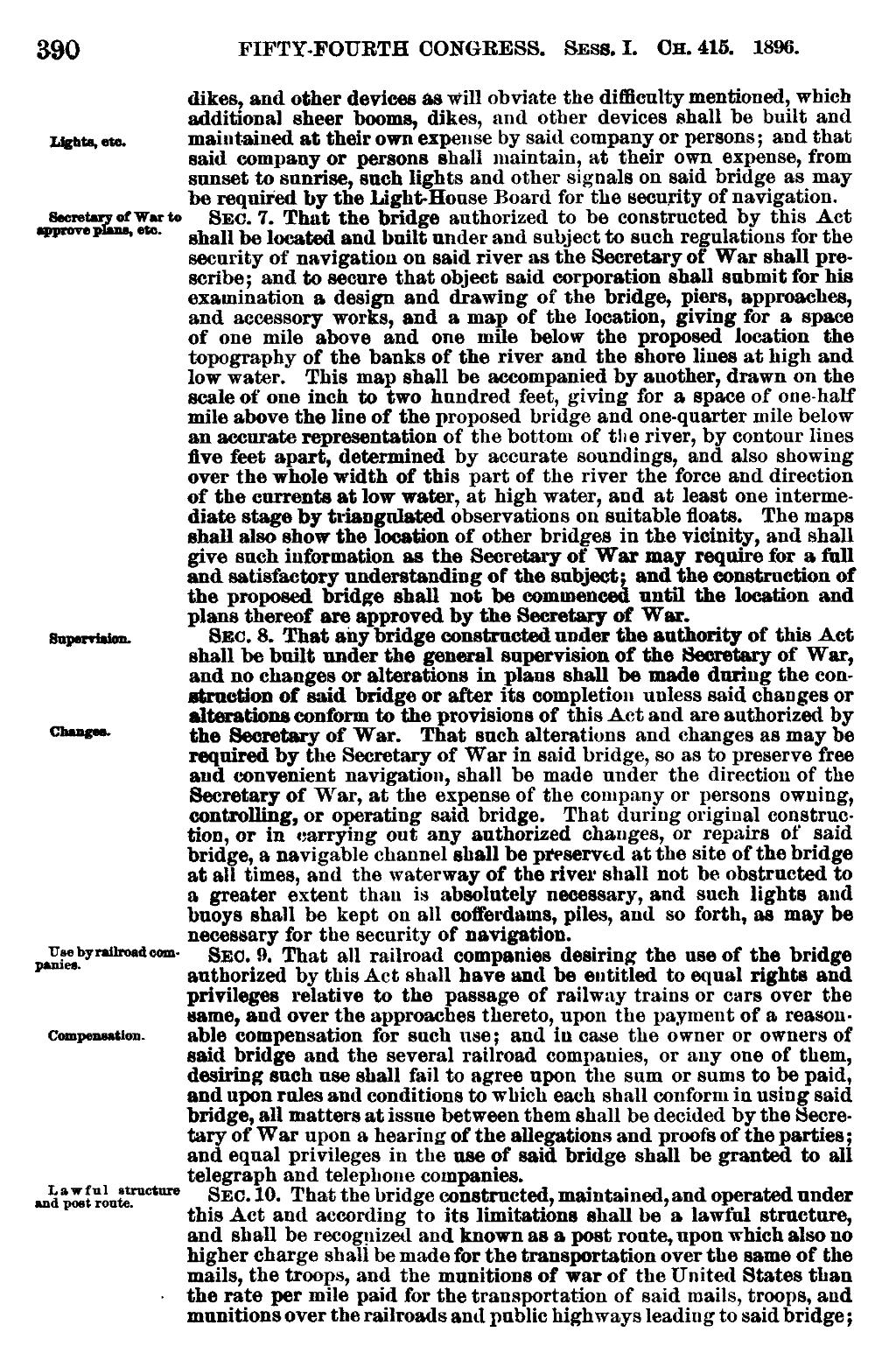390 FIFTY·FOURTH CONGRESS. Sess. I. Ch. 415. 1896. dikes, and other devices as will obviate the difficulty mentioned, which additional sheer booms, dikes, and other devices shall be built and mgm, ea. maintained at their own expense by said company or persons; and that said company or persons shall maintain, at their own expense, from sunset to sunrise, such lights and other signals on said bridge as may be required by the Light·House Board for the security of navigation. 8••=~*;¤K_·:_f.W¤¢¤ Sec. 7. That the bridge authorized to be constructed by this Act °"""° °°°° shall be located and built under and subject to such regulations for the security of navigation on said river as the Secretary of War shall prescribe; and to secure that object said corporation shall submit for his examination a design and drawing of the bridge, piers, approaches, and accessory works, and a map of the location, giving for a space of one mile above and one mile below the proposed location the topography of the banks of the river and the shore lines at high and low water. This map shall be accompanied by another, drawn on the scale of one inch to two hundred feet, giving for a space of one-half mile above the line of the proposed bridge and one-quarter mile below an accurate representation of the bottom of the river, by contour lines live feet apart, determined by accurate soundings, and also showing over the whole width of this part of the river the force and direction of the currents at low water, at high water, and at least one intermediate stage by triangulated observations on suitable floats. The maps shall also show the location of other bridges in the vicinity, and shall give such information as the Secretary of War may require for a full and satisfactory understanding of the subject· and the construction of the proposed bridge shall not be commenced until the location and plans thereof are approved by the Secretary of War. supmaau. Sec. 8. That any bridge constructed under the authority of this Act shall be built under the general supervision of the Secretary of War, and no changes or alterations in plans shall be made during the construction of said bridge or after its completion unless said changes or alterations conform to the provisions of this Act and are authorized by °"*'*¢°’· the Secretary of War. That such alterations and changes as may be required by the Secretary of War in said bridge, so as to preserve free and convenient navigation, shall be made under the direction of the Secretary of War, at the expense of the company or persons owning, controlling, or operating said bridge. That during original construction, or in carrying out any authorized changes, or repairs of said bridge, a navigable channel shall be preserved at the site of the bridge at all times, and the waterway of the river shall not be obstructed to a greater extent than is absolutely necessary, and such lights and buoys shall be kept on all coiferdams, piles, and so forth, as may be necessary for the security of navigation. P·l_f,*,j·l’Y”**'°*‘°°¤· Sec. 9. That all railroad companies desiring the use of the bridge authorized by this Act shall have and be entitled to equal rights and privileges relative to the passage of railway trains or cars over the same, and over the approaches thereto, upon the payment of a reason- 0¤mp·¤¤•¤¤¤- able compensation for such use; and in case the owner or owners of said bridge and the several railroad companies, or any one of them, desiring such use shall fail to agree upon the sum or sums to be paid, and upon rules and conditions to which each shall conform in using said bridge, all matters at issue between them shall be decided by the Secretary of War upon a hearing of the allegations and proofs of the parties; and equal privileges in the use of said bridge shall be granted to all telegraph and telephone companies. m{;‘;,f,'_f‘;f,¤,fa‘f““"° Sec. 10. That the bridge constructed, maintained,and operated under this Act and according to its limitations shall be a lawful structure, and shall be recognized and known as a post route, upon which also no higher charge shall be made for the transportation over the same of the mails, the troops, and the munitions of war of the United States than - the rate per mile paid for the transportation of said mails, troops, and munitions over the railroads and public highways leading to said bridge;
Page:United States Statutes at Large Volume 29.djvu/420
This page needs to be proofread.
